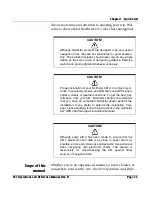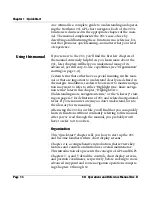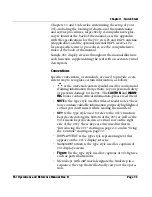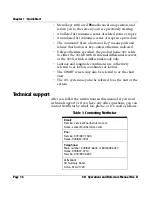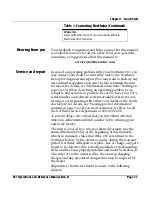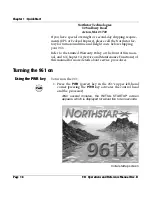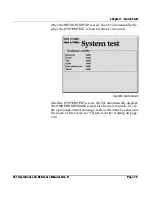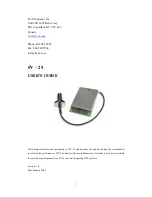
Chapter 1 - Quick Start
Page 1-14
961 Operations and Reference Manual Rev. D
Highlight One: Basic navigation terms
Bearing:
The true or magnetic course from your
present position to a waypoint
.
Coordinates:
Coordinates specify a location on the
earth’s surface using latitude and longitude (see
this table), Loran-C TDs, or distance and bearing
from a fixed location. (the term TDs refers to
Loran-C Time Differences; for details, see the Glos-
sary.)
Course-over-ground (COG):
The actual path of
your vessel in relation to the surface of the earth;
that is, the direction your vessel is actually moving.
Cross-track error (XTE):
The distance between
your position and your desired track; that is, how far
off you are from your intended course line. The 961
displays XTE numerically (as either nm, mi, or km)
and graphically.
Desired track:
An imaginary line that the 961 cal-
culates, which represents the path that you plan to
follow, usually from one waypoint to the next. On
the
CHART
screen, the 961 displays the desired
track as a green line.
Global Positioning System (GPS):
Developed by
the U.S. Department of Defense, GPS is a satellite
navigation system that computes your position
using signals from a system of 24 earth-orbiting
satellites.
Latitude:
Imaginary lines on the earth’s surface
running east/west, expressed as the number of
degrees (0 to 90) north or south of the Equator.
Leg:
The line, or path, between two waypoints in a
route or a trip.
Longitude:
Imaginary lines on the earth’s sur-
face running north/south, expressed as the
number of degrees (0 to 180) east or west of the
Prime Meridian, a line running from the North
Pole to the South Pole.
Nautical mile (nm):
One nm equals 6,076 feet,
compared to a statute mile, which is 5,280 feet.
A nautical mile also equals one minute of lati-
tude.
Position:
See Coordinates.
Route
:
A sequence of waypoints forming a con-
nected path to and/or from specific locations. A
typical route consists of a starting waypoint, a
destination waypoint, and a series of legs con-
necting those waypoints. On the
CHART
screen, the 961 displays a route as a dark blue
line. (If you’re “following” a route, however, the
961 copies the route into the 961’s trip, so it isn’t
displayed as dark blue anymore. For details
about following a route, see ”What is a route?”
starting on page 8-2.)
Speed-over-ground (SOG):
The actual speed
of your vessel in relation to the surface of the
earth; that is, the speed your vessel is actually
going.
Track:
As used in 961 operations, a path that
you either plan to follow or have already fol-
lowed. For complete details about the track fea-
ture, see ”Introducing tracks” starting on page
9-2.
Waypoint:
A specific position defined by its
coordinates of latitude and longitude, TDs, or
distance and bearing, and used as either an
intermediate or a final destination.
Содержание 961X
Страница 1: ...961 961 GPS Chart Navigator Operations and Reference Manual P N GM1700 Revision D X XD ...
Страница 8: ...Page viii 961 Operations and Reference Manual Rev D ...
Страница 10: ...Page x 961 Operations and Reference Manual Rev D ...
Страница 58: ...Chapter 2 Introducing the 961 Page 2 16 961 Operations and Reference Manual Rev D ...
Страница 140: ...Chapter 5 Understanding Position Coordinates Page 5 12 961 Operations and Reference Manual Rev D ...
Страница 172: ...Chapter 7 Creating Avoidance Points Page 7 16 961 Operations and Reference Manual Rev D ...
Страница 198: ...Chapter 8 Creating Routes Page 8 26 961 Operations and Reference Manual Rev D ...
Страница 262: ...Chapter 12 Alarms TideTrack and Currents Page 12 16 961 Operations and Reference Manual Rev D ...
Страница 348: ...Chapter 14 Service and Maintenance Functions Page 14 20 961 Operations and Reference Manual Rev D ...
Страница 374: ...Index Page I 12 961 Operations and Reference Manual Rev D ...




